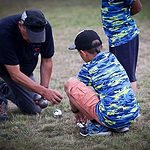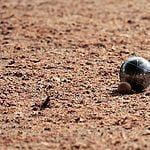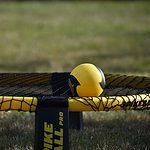Ever wondered about the exact number of bags used in a game of cornhole?
You may have heard various theories, but the definitive answer can impact your gameplay significantly.
Understanding the precise quantity of bags involved not only ensures adherence to the rules but also influences your strategy and scoring potential.
Let's uncover the crucial details surrounding the number of bags in cornhole and how this fundamental aspect shapes the game dynamics.
Key Takeaways
- Regulation cornhole games use 8 bags, 4 per team, for fair play and consistent scoring.
- Each player handles 4 bags, totaling 8 per team, crucial for achieving the winning score of 21 points.
- Bag allocation involves 2 bags of one color and 2 of another per team, promoting fairness and skill display.
- Strategic gameplay in cornhole hinges on bag count, placement, and adaptability for offensive and defensive success.
Cornhole Bag Quantity
When playing cornhole, it's essential to have a total of eight bags, with each team using four bags to ensure a fair and balanced game. The game of Cornhole revolves around these eight bags, each team throwing their designated set to score points. Players aim to toss their bags onto the cornhole boards to earn points, with each successful bag landing on the board counting for one point and a bag that goes through the hole scoring three points.
Standard Bag Count
In a standard game of cornhole, each team is equipped with two sets of bags, totaling eight bags with four bags per team. The bags are typically 6 inches by 6 inches in size, and teams take turns throwing their 4 bags towards the opposing cornhole board. The number of bags in cornhole is crucial for scoring and gameplay strategy.
- Each team has 4 bags, 2 sets of different colors.
- The total number of bags in a cornhole game is 8, with 4 bags per team.
- Each bag is typically 6 inches by 6 inches in size.
- Teams take turns throwing their 4 bags towards the opposing cornhole board.
- The number of bags in cornhole is important for scoring and gameplay strategy.
Having the right number of bags ensures a fair and balanced game, allowing both teams to compete effectively. With 4 bags per team, players have multiple opportunities to score points and showcase their throwing skills. The standard bag count in cornhole sets the stage for an engaging and competitive match where strategy and precision play a significant role in determining the winner.
Regulation Bags in Cornhole
Have you ever wondered what makes regulation bags in cornhole different from standard bags?
In regulation Cornhole games, each team consists of two people and uses a total of 8 bags, with 4 bags designated for each team. These regulation bags must adhere to specific dimensions, measuring 6 inches by 6 inches and weighing 1 pound.
The bags are typically made of durable duck cloth and filled with corn to achieve the required weight and feel.
Ensuring that the correct number of regulation bags is used in a game is crucial for maintaining fair play and scoring consistency. By following these regulations, players can enjoy a level playing field, enhancing the competitive aspect of the game.
Number of Bags per Player
To ensure a balanced and strategic gameplay experience, each player in a Cornhole match typically handles four bags, totaling eight bags per team. As players take turns throwing their designated bean bags towards the opposite cornhole board, the number of bags per player becomes crucial for fair play and effective strategy.
Here's a breakdown of key points regarding the number of bags per player:
- The team shall have four bags per player, ensuring an equal distribution of throwing opportunities.
- Each player throws one bag at a time, aiming to score points either on the board or through the hole.
- The team reaches 21 points to win the game, with the scoring based on the bags' placements.
- Winning teams often showcase a mix of skillful throws and tactical bag placements.
- It's essential for players to be mindful of the rules, such as ensuring no player's foot goes past the front edge of the board when the team throws.
Bag Total in Cornhole Game
As players engage in a game of Cornhole with their designated bags, the total number of bags utilized becomes a critical factor in ensuring a balanced and competitive gameplay experience. In accordance with Cornhole Rules, a standard game consists of 8 bags, with each team having 4 bags of the same color. This setup allows for strategic play and fair competition between the two opposing teams.
During a round, each team must take turns throwing their designated bags towards the Cornhole board on the opposite end. The objective is for a team to reach the specified score by successfully landing their bags into the hole or on the board.
The number of bags in play not only impacts the flow of the game but also contributes to the overall excitement and engagement of the players. Therefore, the bag total in a Cornhole game is carefully determined to ensure an enjoyable and level playing field for all participants.
Bag Allocation in Cornhole
When considering bag allocation in Cornhole, each team is provided with 4 bags, consisting of 2 of one color and 2 of another color, ensuring a balanced and competitive gameplay experience.
- The team that scores in the previous round gets to throw first in the next round.
- Each team is equipped with 4 bags in total, 2 bags of one color and 2 of another color.
- Players on a team each have 2 bags to throw, allowing for strategic gameplay.
- The bags are evenly divided between the partners on a team, promoting fair participation.
- This allocation of bags ensures that both teams have an equal opportunity to showcase their skills and aim for victory in the game of Cornhole.
Bag Quantity Rules
Considering the bag allocation in Cornhole and the standard setup of 8 regulation size bags, understanding the bag quantity rules is essential for maintaining the integrity of the game and ensuring a balanced playing field.
In a game of Cornhole, each team has 4 bags of one color, amounting to 8 bags in play. Players take turns throwing these 8 bags, aiming to land them on the board or, ideally, get the bag in the hole. A player may throw all 4 bags in a row from anywhere behind the front of the Cornhole board.
If a bag goes through the hole, it scores 3 points, while a bag on the board scores 1 point. Points are tallied after each round based on the bags' positions. This setup not only adds strategy to the game but also ensures that each team has an equal opportunity to score points.
Maintaining the correct bag quantity is crucial for a fair and enjoyable playing experience.
Bags Needed for Cornhole
To ensure a balanced and fair game of Cornhole, each team requires 4 bags, totaling 8 bags for the game. The Bean Bag Toss game is all about accuracy and skill, and having the right number of bags is crucial for a smooth gameplay experience.
Here are some key points to consider when it comes to the bags needed for Cornhole:
- Each team needs 4 Cornhole bags to play the game effectively.
- The bags should be of equal weight and size to maintain fairness.
- If a bag hits the ground before reaching the playing surface, it's considered a foul bag.
- Make sure the bags are thrown from behind the front of the cornhole board to follow the rules.
- Having the correct number of cornhole bags is essential to ensure that each team reaches their full potential during the game.
Bag Quantity Per Round
In a standard game of Cornhole, each team throws a total of 8 bags per round, with 4 bags allocated to each team for individual tosses. The first team to pitch will have 4 bags to throw towards the opposing board. Players take turns, making alternating throws until all 8 bags have been tossed.
The objective is to land the bag into the hole or on the board for points. When it's your turn, you must throw from behind the front edge of the board, and you'll have 4 bags to make your mark. Remember, accuracy and strategy are key in aiming for the hole or landing on the board to score points.
Keeping track of the bag count and maximizing your opportunities in each round can greatly impact your overall game performance. Stay focused, aim true, and make the most of your 4 bags per round.
Cornhole Bag Count
When strategizing in Cornhole, the count of bags on the playing field plays a pivotal role in determining your gameplay tactics and scoring efficiency. Here are some key points to consider regarding the Cornhole bag count:
- Each team reaches a total of 4 bags, resulting in 8 bags on the playing field.
- The 8 bags are typically split into 2 sets of 4 bags, each set being a different color for easy identification.
- The bags of one team are aimed at the opponent's board to score points.
- The bags that land on the board are worth points, while those that miss don't contribute to the score.
- The game continues until a winning score is reached, often decided by a coin flip to determine which team starts playing.
Understanding the Cornhole bag count is essential for formulating your game plan and maximizing your chances of scoring points efficiently. By strategizing around the number of bags in play, you can enhance your gameplay and increase your chances of victory.





